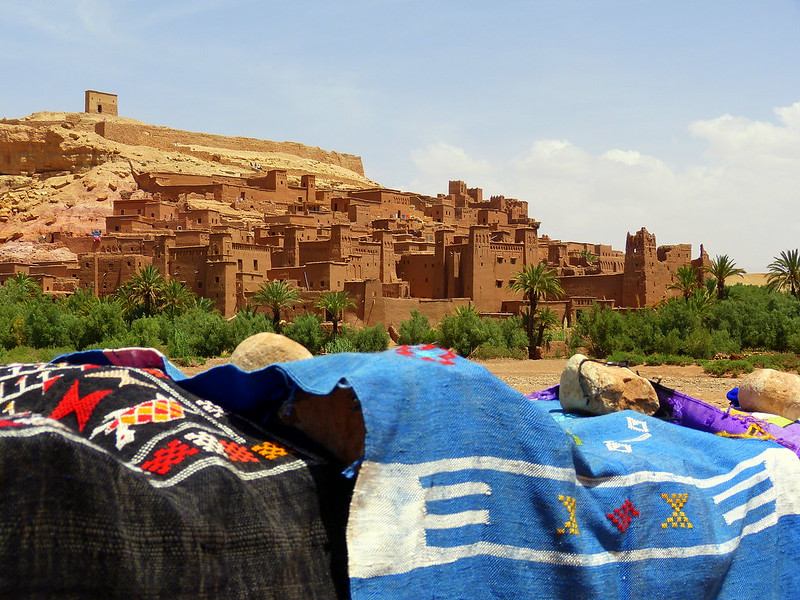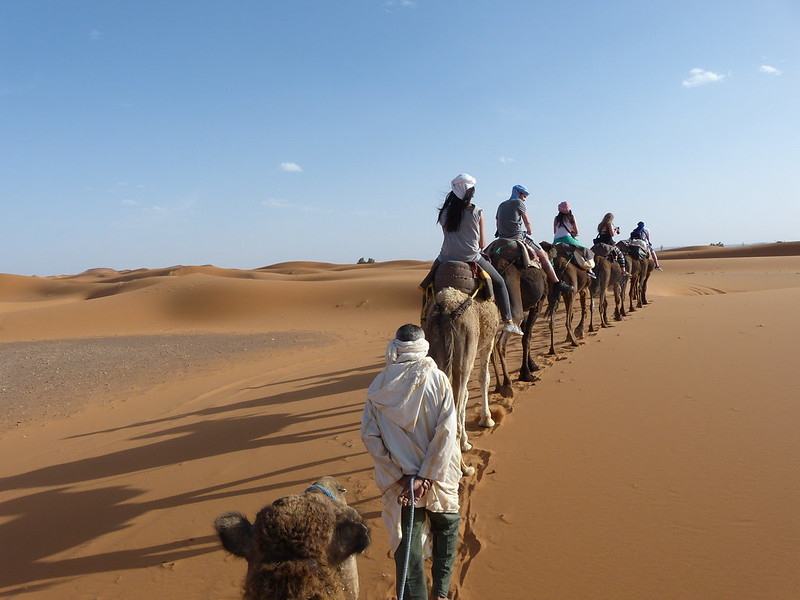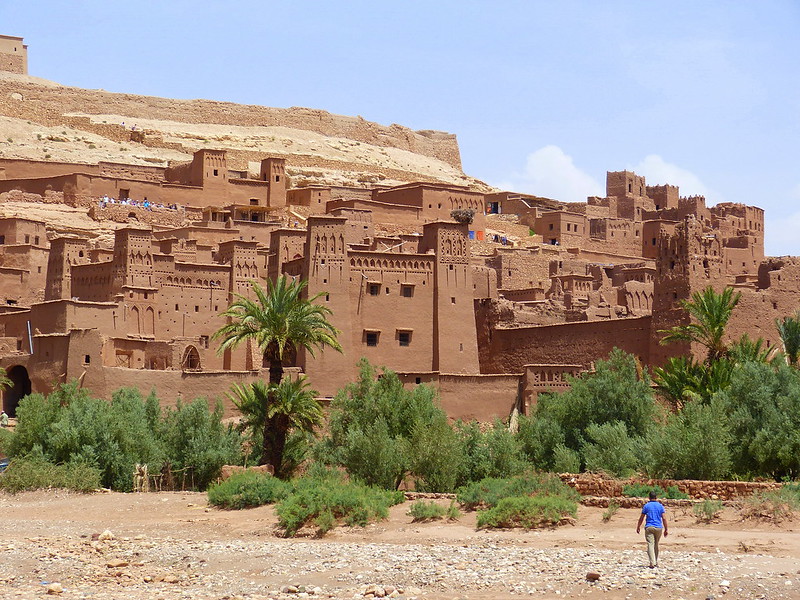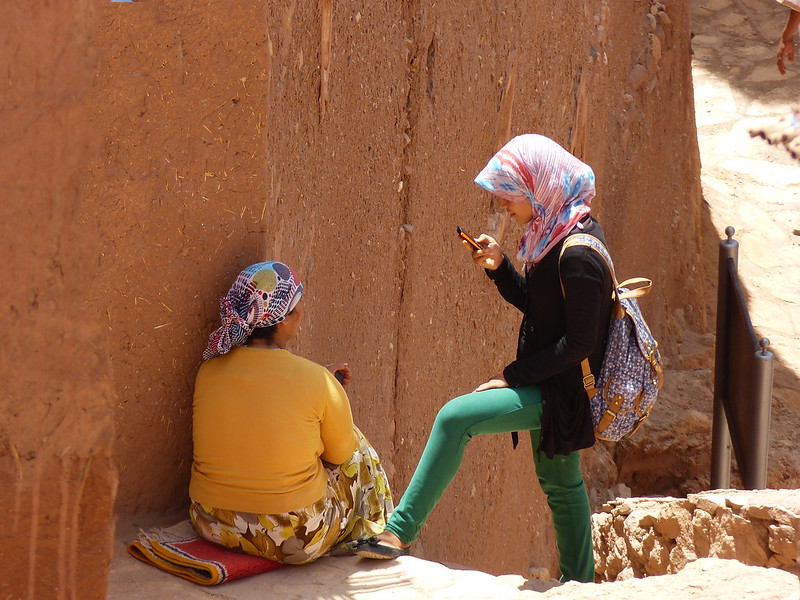For many people the highlight of a visit to Morocco is a trip to the Sahara, the biggest desert on earth and a natural habitat that every traveller wants to see once in his life. I was a bit different from the others who only want to see the dunes, nevertheless. I hoped to see the desert of course, but I knew that I wanted to explore all of this fascinating region of North Africa, and especially to see with my own eyes that legendary citadel in the desert that seems to be made out of sand: Aїt Benhaddou. It's been used in dozens of movies: whenever they need an exotic city in the desert that barely seems real, they use it. It had been a dream of mine for some time to visit it, and so it was very high on my list of places to see in Morocco.
 |
| Ait Benhaddou |
Because the actual sand dunes are very far from Marrakesh - about 350 kilometres to Zagora and 550 kilometres to Merzouga - the tours from this city usually offer multi-day trips to the pre-Saharan region, with visits to kasbahs, gorges and Berber villages, as well as the classic camel ride and camp night in the desert. An alternative is to take a bus to Ouarzazate and then explore from there hiring a taxi or a private car, but seen the prices of the small-group tours I decided to join one. In this way, I also made many new friends from all over the world!
I decided to join a three-day two-night trip to Merzouga, the dunes close to the border with Algeria that are famous for their beauty. On the way, we would be stopping at Aїt Benhaddou. The trip was very cheap, 850 dirhams (74€) for transportation, accommodation, all the dinners and breakfasts included, plus the camel ride and the guided tour of Aїt Benhaddou. As with everything in Morocco, prices can change, and you must be clever (or lucky!) to get a good bargain. Not everything in this tour was perfect (more of this soon), but if I look back and think of how little I paid for three days of adventure and lots of bucket list filling, I don't mind.
 |
| Camel ride at sunset |
The group wasn't too big, thirteen people, and it couldn't have been more varied: we were all young, but from many different countries, including Brazil, Sweden and France. The drive from Marrakesh was very interesting, not to mention scenic: the landscape kept changing, from fertile valleys to mountains and cultivated terraces. For the first two hours or so of the trip, the landscape reminded me of Crete: the somehow-barren mountains, the whitewashed buildings with flat roofs, and the relaxed atmosphere were all reminiscent of that European island.
We drove through the Atlas Mountains, one of the most important mountain chains in North Africa, until we reached more than 2,000 metres above the sea level. The Atlas mountains cut all of Morocco, and there is snow there in the winter. We also stopped at a few viewpoints, where I was surprised to see earthenware utensils and souvenirs being sold by the guard rail. The vendors here weren't pushy, but rather hoping to sell something.
 |
| Selling earthenware by the guardrail |
Just before lunchtime we reached our first stop, the UNESCO-listed heritage site of Aїt Benhaddou. As soon as we got off the bus we were met by our guide, dressed in Touareg clothes, with a blue turban and a loose white tunic. These were probably for the show, rather than his everyday clothes. His name was Mohamed, and I was astonished when he addressed me in very good Italian, telling me about one of his friends who now lives in Trento. Here I was in the middle of nowhere, at the edge of the Sahara desert, and my guide could speak Italian! I wondered if Mohamed was from this region, or if he had arrived here from another part of Morocco to work in the tourism industry.
He led us through the alleys of the village. The buildings were made of earth and straw, while carpets and other colourful souvenirs where hanging from the walls. The light was incredible, so bright and full! No wonder this location has been used for many movies and TV shows, including an episode of "Game of Thrones".
 |
| Our guide leading us through the streets of Ait Benhaddou |
I really couldn't believe that I was finally there! I had seen the pictures of this place countless times, but from the glossed page of a magazine it looked unreal, so legendary and mythical, tucked as it is at the edge of the Sahara desert, in a remote corner of Morocco. Places like Machu Picchu in Peru or Petra in Jordan can make you doubt that they're real. And yet I was there, sweating profusely, but staring at it.
 |
| In front of Ait Benhaddou |
We arrived at the riverbed, where you enjoy a great view of the ksar. It was spring, and the river was dry, but the guide pointed at a pedestrian bridge - honestly a rather ugly one - that connects the citadel to the modern village, telling us that it is not always so, and that in other seasons the bridge is very much needed. UNESCO strongly encouraged the authorities to build it because it makes it easier for villagers to reach the houses situated inside the fortifications, and therefore also to live or transport materials.
There is no entrance fee to see the ksar of Aїt Benhaddou, even though at a certain point the guide mentioned 25 dirhams that would go to the restoration of the place. Some of us didn't hand in the money, and they didn't seem to care. I still wonder if that was more of a tip than a real entrance fee.
 |
| Another stunning picture of Ait Benhaddou |
The words ksar and kasbah are sometimes used interchangeably, but technically a kasbah is a palace-fortress, often inhabited by the ruling family, while a ksar (same root as the word alcázar in Spanish) is the fortified village growing around it, and it often includes many kasbahs. Kasbahs and ksour (the plural form of ksar!) are placed on the caravan routes between the Sahara desert and Marrakesh. They are made of earth and straw, with towers and a few windows. The walls are often decorated with simple but beautiful patterns. Aїt Benhaddou is only the most impressive and famous example of this kind of southern Moroccan architecture, but there are dozens in this region. The oldest among the buildings in Aїt Benhaddou "only" dates back to the 17th century, but this style of architecture is much older, probably going back to the 8th century.
 |
| Another detail of the ksar |
I had always wondered what there is inside this mythical citadel: if there were houses and a real town, if people still lived there, and what their daily routine consisted of. As we learned during our tour, there is not much inside the fortified walls of Aїt Benhaddou. The streets of the citadel are mostly bare and so are the earthen buildings. Many areas appear to be in need of restoration, because unfortunately every time it rains the earthen buildings are damaged. UNESCO protects this site, but - at least according to our guide - it mostly cares about the outer perimeter and the houses that look upon the lanes. Nowadays only a few families live inside the historical citadel of Aїt Benhaddou, without electricity or running hot water. Most of the people have moved to the village on the other side of the river.
 |
| Girls in Ait Benhaddou |
You can still see the place where they built the arena for "The Gladiator". Did they really think they could get away with a Roman arena in the middle of the desert, when the Romans didn't even reach the desert in the first place? I need to rewatch that movie and laugh my arse off that part!
We all climbed to the top of the citadel, from where you can enjoy a 360° view of the surrounding semi-desertic landscape, with lots of palm trees. It was here that we lost our guide! Seriously, we climbed back down and we couldn't see him. We somehow managed to make our way through this restaurant where apparently every tour group was led to.
 |
| View from the top |
Aїt Benhaddou is in a stunning position, isolated and truly in the middle of nowhere. We passed by many other buildings of this kind, like the Taourirt Kasbah in Ouarzazate, which was equally beautiful. Unfortunately, next to these very beautiful architectural masterpieces there were often modern or run-down buildings that spoiled the landscape.
 |
| Taourirt Kasbah in Ouarzazate |
I am absolutely charmed by the architecture of this part of Morocco. I kept staring at the buildings from the window of the mini-bus for the rest of the day (there was a lot of driving on that tour).
 |
| A corner of Ouarzazate |
Wow, I LOVE all your photos!! I'm definitely adding this to my Morocco to do list! Hopefully I'll get a chance to go sometime next year! :)
ReplyDeleteThank you, it's so good to receive compliments...
DeleteChoose Morocco Tour Package and get unlimited fun on your journey. Experience the local experience with a local tour guide who will guide you through all the streets, raids, palaces, and all other historical places according to your trip plan.
ReplyDeleteThanks for the information you have provided in your blog as it proved to be very helpful for me in start writing my own blogs you have provided in this blog as it proved to be very helpful to me.
ReplyDeleteCamp in Jaisalmer